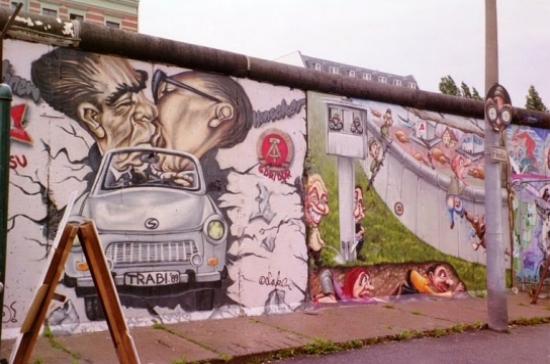Last weekend, in scenes reminiscent of 1989, thousands of protesters gathered at the Berlin Wall. Only this time they weren’t there to tear it down, but to show their opposition to the demolition of one of the last remaining sections.

The East Side Gallery is the longest remaining stretch of the wall and is home to one of the city’s most iconic images. The painted mural of former Soviet and East German leaders Leonid Brezhnev and Eric Honecker sharing a passionate kiss continues to be one of the most popular attractions in the area, and its future is in jeopardy due to a proposed property development.
A large portion of the 1.3 km open-air gallery, which also features the work of painters from all over the world, is due to be torn down. A mixed use development featuring flats and offices will be erected in its place.
Developer Living Bauhaus is proposing to build a 63-metre tower on the site which they describe as a “totally new dimension of life and living” that will offer occupiers “breathtaking panoramic views.”
A 50-foot hole has already been punched into the wall to make room for a boat landing stage. The panel was removed to provide an open view of the river from the O2 World arena, next to the gallery.
Opponents say that tearing down the artwork will detract from the “aesthetics of the gallery,” which attracts 800,000 people to the site annually. They also state that it insults the memory of those who were killed attempting to escape communist East Germany.
Sascha Disselkamp, the manager of the Sage nightclub told the Guardian; “In this very place people died, and the idea of building luxury flats here would be like erecting a petrol station in front of one of Berlin’s museums.”
Kani Alavi, the head of the artists’ initiative East Side Gallery, stated that the entire structure was under threat.
He said, “We see this act as a direct act of destruction towards the artwork, to the extent that you might as well tear the whole thing down.”
The stretch of the wall that would have to be removed for the development includes a section featuring the work of French artist Thierry Noir. The 54-year-old joined protesters calling for the wall’s preservation.
He said, “All the paintings have become a symbol of freedom in Berlin and Europe. Unlike elsewhere in the city, where the majority of the wall has been removed, this is a unique opportunity to preserve a large section of what was once a death strip.
“If you remove the sections, you’re destroying the authenticity of this place.”
The district’s mayor, the Green MP Franz Schulz, has confirmed that parts of the wall will have to be removed and that the investor has the legal right to do so.
Schulz pointed out that removing the wall would also make room for a new walkway for pedestrians and cyclists. It will be a reconstruction of a bridge that was destroyed by bombs during the war. It will also provide an emergency exit for visitors to the Spree Park, located next to the building.
A spokesman for Living Bauhaus confirmed that the removal of the stretch of the wall will continue shortly. However, he was keen to reassure Berliners that the murals won’t be destroyed. Instead the developers will reconstruct the section in a nearby riverside park.